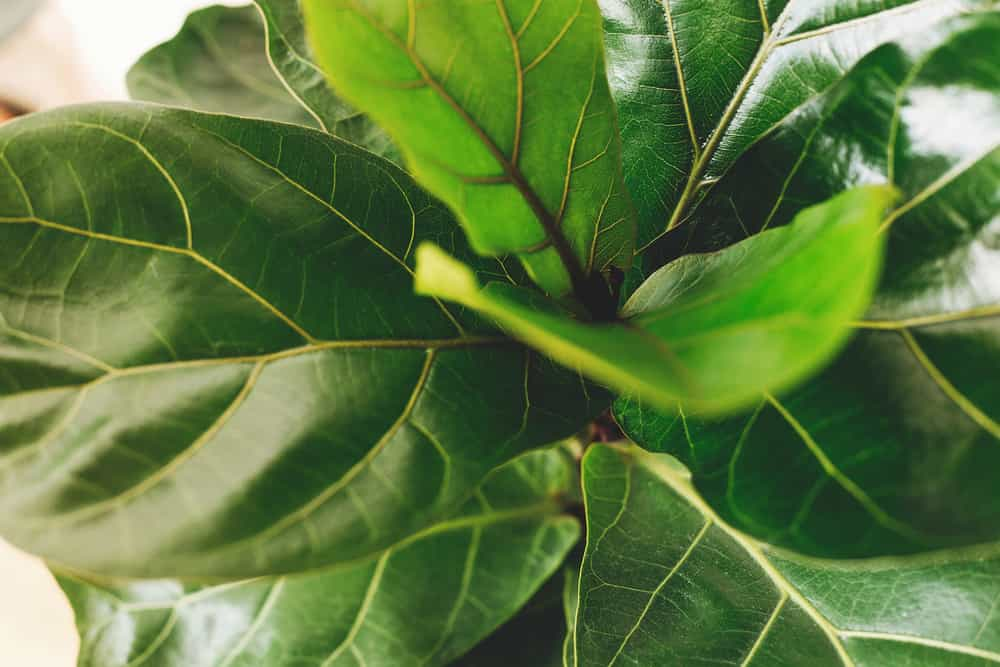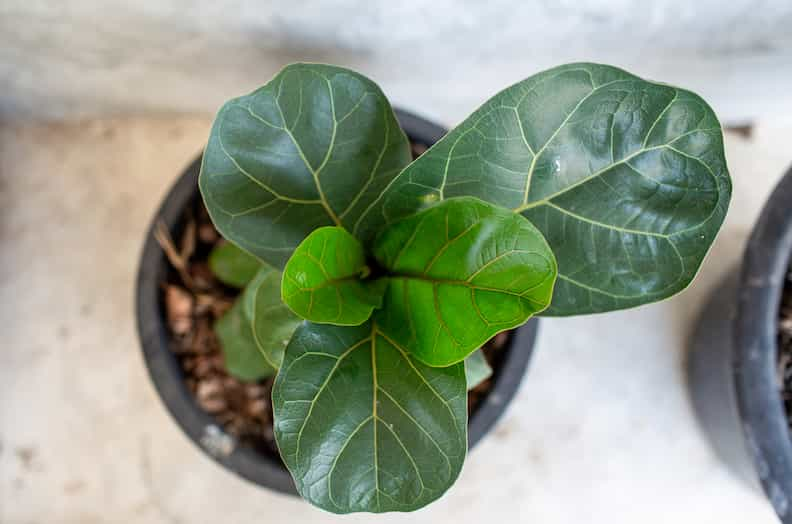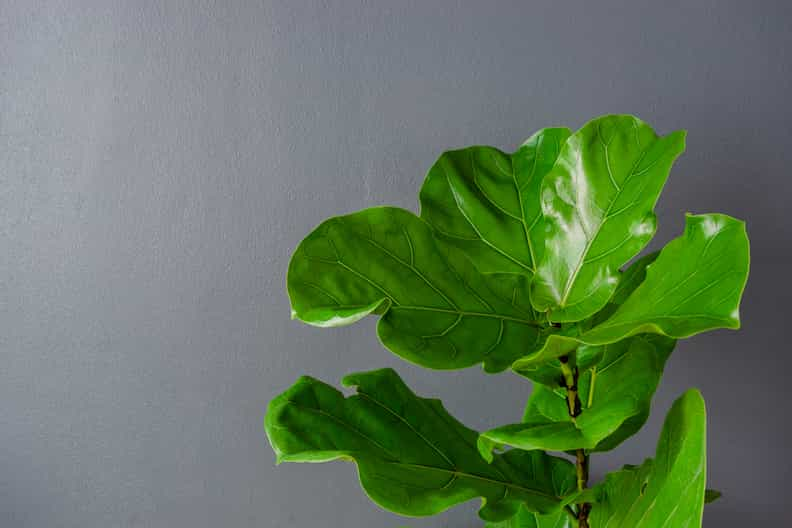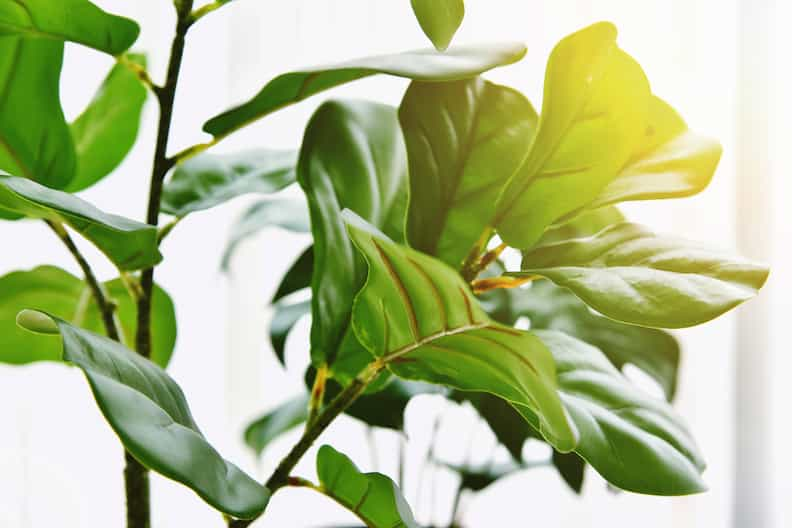Fiddle leaf fig trees are a much-loved houseplant that has an easy-going nature combined with an attractive appearance that indoor gardeners flock to.
However, before you rush out and purchase this tropical plant, make sure you are aware of the maximum size these lush and oversized ornamental figs can get.
Knowing how big large fiddle leaf figs will get helps to ensure you select the right location for this stunning plant.

Table of Contents
How big do fiddle leaf fig trees get?
Most large fiddle leaf figs will reach about 10 feet tall when grown indoors, with almost all varieties reaching at least 6 feet tall. Keep in mind, however, that the size of the fiddle leaf fig will depend on various factors, such as the exact type of fiddle leaf fig and how well it is cared for.
Fiddle leaf fig trees aren’t fast growers, and it can take 10 years or more for this plant to reach its mature height. Within 4 years, however, the large fiddle leaf fig tree should grow tall enough to be an attractive ornamental plant for indoor gardeners.
How do you grow a giant fiddle leaf fig?
In order to grow a giant fiddle leaf fig, you will need to ensure the plant has the optimal growing conditions. Without this, even the largest species of fiddle leaf fig tree would falter and not reach its maximum height potential.
1. Container size
The right container size is important to ensure your fiddle leaf fig grows as large as possible. Choose a pot that has a diameter 3 to 4 inches wider than the pot the plant came in.
Be wary, however, not to select a container that is more than 6 inches larger in diameter as this could increase the chance of root rot threatening your fiddle leaf fig.

2. Drainage
Another important aspect to consider is drainage in the container the large fiddle leaf fig tree is growing in. Without proper drainage, the soil will become soggy and the plant runs the risk of developing root rot or other fungal diseases.
Thankfully, you can help prevent this from ensuring the container the plant is growing in has drainage holes along the bottom of the pot.
3. Water
Water is an important aspect to the overall health and wellness of your plant, as well as the fiddle leaf fig’s ability to grow as big as possible. Fiddle leaf figs grow best when they are watered deeply, which means watering until excessive water runs out of the bottom of the drainage holes.
When it comes to how often to water a fiddle leaf fig, let the soil dry out a little in between waterings and only water when the first 2 inches of soil feel dry. This will help prevent fungal problems, such as root rot, which could kill the fiddle leaf fig.

4. Soil
Soil and water go hand and hand when it comes to plants, and growing your fiddle leaf fig in the wrong type of soil can cause more harm than good. Make sure to select soil that is light and airy, and has good drainage.
Peat-based soils that contain perlite are the ideal soil for fiddle leaf figs. This mixture is typically found in most indoor potting mixes available for purchase. Another option is to create your own by combining 1/3 perlite with 2/3 peat.
5. Sunlight
Fiddle leaf figs thrive in areas where they receive bright but indirect sunlight. It may be tempting to sit the plant in a corner where it looks the most aesthetically pleasing, but this could spell disaster for the health of the plant.
Instead, choose a location where it can get bright light that is either filtered or indirect.
Find out more: What Are Your Fiddle Leaf Fig’s Light Needs?
6. Temperature
Like most indoor houseplants, a large fiddle leaf fig tree prefers temperatures that fall between 60 and 80 degrees Fahrenheit.
Furthermore, make sure to keep the plant away from areas where the temperature can fluctuate drastically. Examples of these areas are near exterior doorways or heating and cooling vents.

7. Nutrition
While fiddle leaf figs aren’t heavier feeders, they do benefit from a balanced organic fertilizer feed during their growing season, which is spring and summer. Fiddle leaf figs also do well when the recommended fertilizer dosage is diluted, but the amount of feeding is increased.
For best results, take the recommended dosage, which is found on the fertilizer bottle, and half it. Then feed the fiddle leaf fig tree weekly with the weakened fertilizer.
Related: What’s the Best Fiddle Leaf Fig Fertilizer for Your Plant?
How do you care for a large fiddle leaf fig tree?
Caring for a large fiddle leaf fig tree isn’t difficult, and is actually one of the easier indoor plants to grow. The plant only requires well-drained soil, ample water, bright indirect sunlight, and temperatures between 60 and 80 degrees Fahrenheit.
Despite these relatively simple requirements, the proper care for this plant can get overlooked. When this occurs, the plant suffers and you could even notice your fiddle leaf fig not growing new leaves any more or other examples of stunted growth, which will result in the plant not reaching its full height potential. Thankfully, you can avoid this by providing the fig with the proper care.

How much does a large fiddle leaf fig cost?
A mature fiddle leaf fig can cost, on average, between $100 and $300. Keep in mind that this cost varies on several factors, including the age of the plant, size, health, and location. Where you purchase the plant from can also affect its price.
For example, you may pay more for a large fiddle leaf fig tree from a local nursery than if you bought it from a big box store.
However, the quality of the plant is usually better and the tree healthier when purchased from a local nursery than from a chain store, such as Lowe’s.
For those indoor gardeners on a budget, you can save money by choosing a younger and smaller fiddle leaf fig tree. The smaller and younger the plant, the lower its price tag typically is. Keep in mind, however, that selecting a smaller plant does mean it will take longer to reach maturity.
